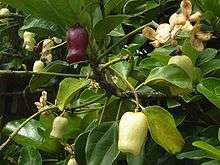Atuna racemosa
Atuna racemosa is a tree in the family Chrysobalanaceae. The specific epithet racemosa is from the Latin meaning "clustered", referring to the inflorescence.[2] The tree is widely known as tabon-tabon in the Philippines, where the fruits have been traditionally used for the preparation of kinilaw (a local dish of raw fish in vinegar or citrus juices) for almost a thousand years.[3]
| Atuna racemosa | |
|---|---|
 | |
| Flowers of Atuna racemosa from Tonga, where it is known as the pipi tree | |
| Scientific classification | |
| Kingdom: | Plantae |
| Clade: | Tracheophytes |
| Clade: | Angiosperms |
| Clade: | Eudicots |
| Clade: | Rosids |
| Order: | Malpighiales |
| Family: | Chrysobalanaceae |
| Genus: | Atuna |
| Species: | A. racemosa |
| Binomial name | |
| Atuna racemosa Raf.[1] | |
| Subspecies | |
|
A. racemosa subsp. excelsa A. racemosa subsp. racemosa | |
| Synonyms[1] | |
|
List
| |
Description
Atuna racemosa grows up to 35 metres (110 ft) tall. The smooth bark is grey to black. The flowers are blue or white. The fruits are ellipsoid, roundish or pear-shaped and measure up to 7.5 cm (3 in) long.[2]
Distribution and habitat
Atuna racemosa is found widely in Thailand, Malesia and the South Pacific islands of Oceania. Its habitat is mixed dipterocarp forests, also in swamps and along rivers, from sea level to 750 metres (2,500 ft) altitude.[2]
Uses
The fruit is made into a putty for sealing canoes in the Pacific islands. Oil from the seeds is used as a scent. Leaves are used as thatch in Fiji.[2]
In the Philippines, where the tree is known as tabon-tabon, juice from the grated flesh of the fruits is used to neutralize the fishy taste and the acidity of the raw seafood dish kinilaw. The remains of halved tabon-tabon fruits alongside cut fish bones have been recovered from the Balangay archeological excavation site in Butuan (dated c. 10th to 13th century AD) indicating that this cooking practice is almost a thousand years old.[3][4][5]
References
- "Atuna racemosa Raf". The Plant List. Retrieved 1 June 2014.
- Prance, Ghillean T. (1995). "Atuna racemosa Raf.". In Soepadmo, E.; Wong, K. M. (eds.). Tree Flora of Sabah and Sarawak. (free online from the publisher, lesser resolution scan PDF versions). 1. Forest Research Institute Malaysia. pp. 160–161. ISBN 983-9592-34-3. Archived from the original (PDF) on 27 September 2013. Retrieved 1 June 2014.
- "Tabon Tabon Fruit". Market Manila. 8 January 2008. Retrieved 16 January 2017.
- Alan Davidson (2014). The Oxford Companion to Food. OUP Oxford. pp. 445–446. ISBN 9780191040726.
- Ninah Villa (27 June 2015). "Kinilaw History, Origin and Evolution – Into the Heart of Freshness". Pinoy Wit. Retrieved 16 January 2017.